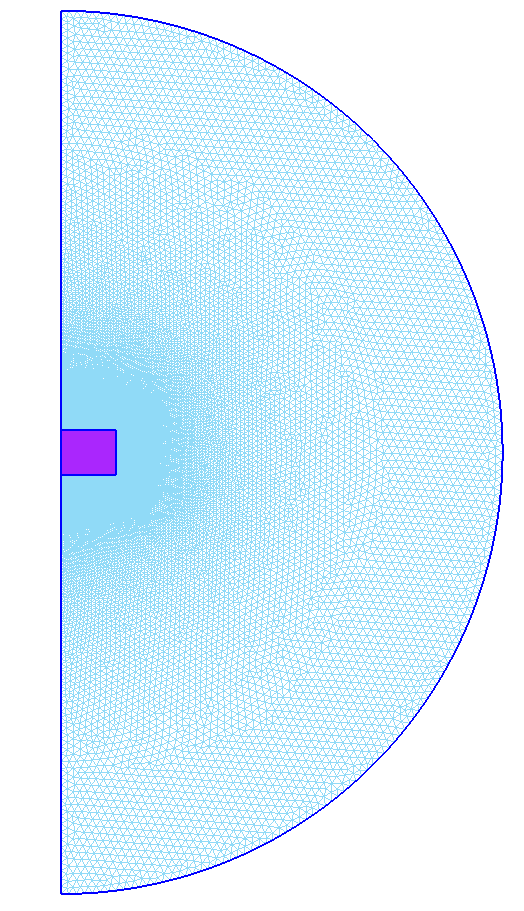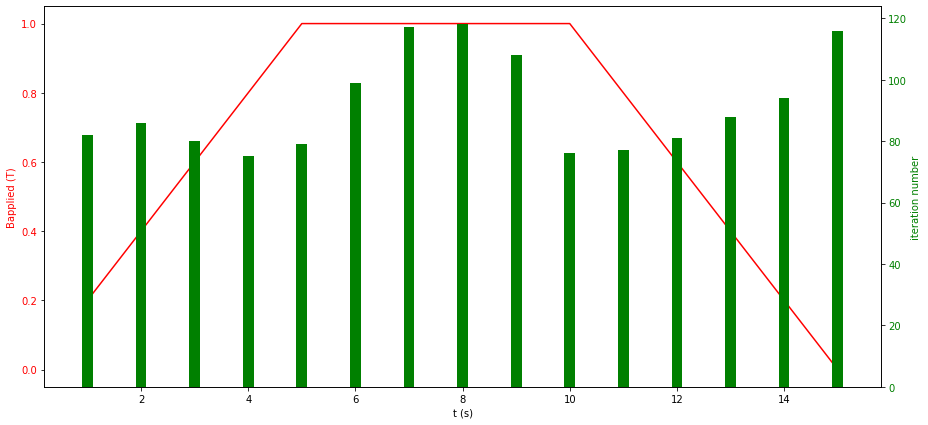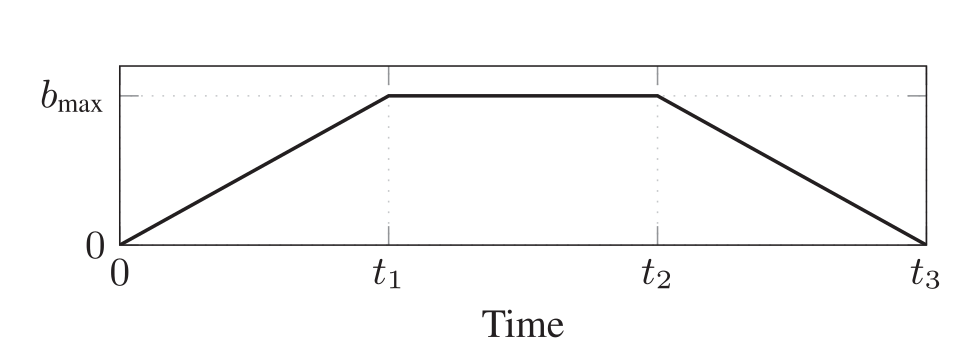Test Case : Feelpp CFPDEs - Bulk Cylinder in Axisymmetric coordinates
1. Introduction
This is the test case of High-Temperature Superconductors with the A-V Formulation and Gauge Condition on a cylinder geometry surrounded by air in axisymmetric coordinates. The formulation used here is the Formulation in axisymmetric coordinates.
2. Run the Calculation
The command line to run this case is :
mpirun -np 16 feelpp_toolbox_coefficientformpdes --config-file=mqs_axis.cfg --cfpdes.solver=Picard --cfpdes.verbose_solvertimer=1
This simulation uses the last version 109 of Feelpp.
3. Data Files
The case data files are available in Github here :
-
CFG file - Edit the file
-
JSON file - Edit the file
-
GEO file - Edit the file
4. Equation
With :
-
\(A_{\theta}\) : \(\theta\) component of potential magnetic field
-
\(\sigma\) : electric conductivity \(S/m\) described by the e-j power law : \(\sigma=\frac{J_c}{E_c}\left(\frac{\mid\mid e\mid\mid}{E_c}\right)^{(1-n)/n} = \frac{J_c}{E_c}\left(\frac{\mid\mid -\partial_t A_\theta\mid\mid}{E_c}\right)^{(1-n)/n}\)
-
\(\mu\) : electric permeability \(kg/A^2/S^2\)
5. Geometry
The geometry is a rectangle in axisymmetric coordinates \((r,z)\) representing a bulk cylinder, surrounded by air.

Geometry in Axisymmetrical cut
|
The geometrical domains are :
-
Cylinder: the cylinder, composed by a conductor -
Air&Spherical Shell: the air surroundingConductor-
Symmetry Line:Air's bound, correspond to \(Oz\) axis (\(\{(z,r), \, z=0 \}\)) -
Exterior Boundary: the rest of theAir's bound
-
Symbol |
Description |
value |
unit |
\(R\) |
radius of cylinder |
\(0.00125\) |
m |
\(H_{cylinder}\) |
height of cylinder |
\(0.001\) |
m |
\(R_{inf}\) |
radius of infty border |
\(0.1\) |
m |
6. Parameters
The parameters of the problem are :
-
On
Cylinder:
Symbol |
Description |
Value |
Unit |
\(\mu=\mu_0\) |
magnetic permeability of vacuum |
\(4\pi.10^{-7}\) |
\(kg \, m / A^2 / S^2\) |
\(t_f\) |
final time |
\(15\) |
\(s\) |
\(b_{max}\) |
maximum applied field |
\(1\) |
\(T\) |
\(rate\) |
rate of the applied field raise |
\(\frac{3}{tf}b_{max}\) |
\(T/s\) |
\(hsVal\) |
time ramp for the applied field |
\(\begin{cases}rate*t &\quad\text{if }t<\frac{t_f}{3}\\b_{max} &\quad\text{if }t<\frac{2t_f}{3}\\b_{max} - (t-\frac{2t_f}{3})*rate &\quad\text{if }t>\frac{2t_f}{3}\end{cases}\) |
\(T\) |
\(J_c\) |
critical current density |
\(3.10^8\) |
\(A/m^2\) |
\(E_c\) |
threshold electric field |
\(10^{-4}\) |
\(V/m\) |
\(n\) |
material dependent exponent |
\(20\) |
|
\(\sigma\) |
electrical conductivity (described by the \(E-J\) power law) |
\(\frac{J_c}{E_c}\left(\frac{\mid\mid e\mid\mid}{E_c}\right)^{(1-n)/n}\) |
\(S/m\) |
-
On
Air:
Symbol |
Description |
Value |
Unit |
\(\mu=\mu_0\) |
magnetic permeability of vacuum |
\(4\pi.10^{-7}\) |
\(kg \, m / A^2 / S^2\) |
On JSON file, the parameters are written :
"Parameters":
{
"mu":"4*pi*1e-7",
"tf":15,
"bmax":1.0,
"rate":"3.0/tf*bmax:tf:bmax",
"hsVal":"bmax - (t-2.0*tf/3.0)*rate + (t<2.0*tf/3.0)*(t-2.0*tf/3.0)*rate + (t<tf/3.0)*(t*rate - bmax):t:tf:rate:bmax",
"jc":3e8,
"ec":1e-4,
"n":20,
"epsSigma":1e-8
},
"Materials":
{
"Conductor":
{
"sigma":"jc / ec * 1.0 / ( epsSigma + ( abs(-magnetic_dAtheta_dt)/ec )^((n-1.0)/n) ):jc:ec:n:epsSigma:magnetic_dAtheta_dt",
"sigma_mod":"x*jc / ec * 1.0 / ( epsSigma + ( abs(-magnetic_dAtheta_dt)/ec )^((n-1.0)/n) ):x:jc:ec:n:epsSigma:magnetic_dAtheta_dt",
\\ [...]
},
},
7. Boundary Conditions
For the Dirichlet boundary conditions, we want to impose the applied magnetic field :
So we have \(B=hsVal\), therefore \(\nabla\times A = hsVal\) and so \(\frac{1}{r}\partial_r (rA_\theta)=hsVal\).
Finally we have :
-
On
Symmetry Line&Exterior Boundary: \(A_{\theta} = \frac{r}{2}hsVal\)
On JSON file, the boundary conditions are written :
"BoundaryConditions":
{
"magnetic":
{
"Dirichlet":
{
"magdir":
{
"markers":["Symmetry_line","Exterior_boundary"],
"expr":"x/2 *hsVal:x:hsVal"
}
}
}
},
8. Weak Formulation
9. Coefficient Form PDEs
The Feelpp toolboxe Coefficient Form PDEs is used here. The coefficients associated to the Weak Formulation are :
-
On
Cylinder:
Coefficient |
Description |
Expression |
\(d\) |
damping or mass coefficient |
\(\sigma r\) |
\(c\) |
diffusion coefficient |
\(\frac{r}{\mu}\) |
\(a\) |
absorption or reaction coefficient |
\(\frac{1}{\mu r}\) |
\(f\) |
source term |
\(0\) |
-
On
Air:
Coefficient |
Description |
Expression |
\(c\) |
diffusion coefficient |
\(\frac{r}{\mu}\) |
\(a\) |
absorption or reaction coefficient |
\(\frac{1}{\mu r}\) |
On JSON file, the coefficients are written :
"Materials":
{
"Conductor":
{
"markers":["Cylinder"],
"sigma":"jc / ec * 1.0 / ( epsSigma + ( abs(-magnetic_dAtheta_dt)/ec )^((n-1.0)/n) ):jc:ec:n:epsSigma:magnetic_dAtheta_dt",
"sigma_mod":"x*jc / ec * 1.0 / ( epsSigma + ( abs(-magnetic_dAtheta_dt)/ec )^((n-1.0)/n) ):x:jc:ec:n:epsSigma:magnetic_dAtheta_dt",
"magnetic_c":"x/mu:x:mu",
"magnetic_a":"1/mu/x:mu:x",
"magnetic_f":"0.",
"magnetic_d":"sigma_mod:sigma_mod"
},
"Air":
{
"markers":["Air","Spherical_shell"],
"magnetic_c":"x/mu:x:mu",
"magnetic_a":"1/mu/x:mu:x"
}
},
10. Numeric Parameters
-
Time
-
Initial Time : \(0s\)
-
Final Time : \(15s\)
-
Time Step : \(1s\)
-
-
Mesh :

Mesh of Geometry
|
11. Solving the Model
In order to solve the non-linearity in the model, several parameters are used in the json and the cfg file :
-
The non-linear solver used is Picard, more efficient when \(\sigma\) is the parameter that contain the e-j power law.
solver=Picard
-
The maximum number of iteration for the non-linear solver is fixed at 600
snes-maxit=600
The time-step is high to help the convergence of the model :
time-step=1
The number of iterations ranges from 80 to 120 :

Number of iteration compared to the evolution of the applied magnetic field
|
12. Results
The results that we obtain with this formulation with Feelpp are compared to the results of the article Finite-Element Formulations for Systems With high-temperature Superconductors where the solver getDP is used.
The time evolution of the applied field is :

Time evolution of the external applied field
|
With \(t_1=5s\), \(t_2=10s\) and \(t_3=15s\)
12.1. Electric current density
The electric current density \(j_\theta\) is defined by :
With :
We compare the current density profiles with Feelpp and getDP on the \(O_r\) axis, at the mid-height of the cylinder, at time \(t_3\) for a maximum applied field of 1 T and \(n=20\).
L2 Relative Error Norm : \(25.09 \%\) |
12.2. Magnetic flux density
The magnetic flux density \(B\) is defined by:
z_component of the magnetic flux density \(b_z (T)\)
|
z_component of the magnetic flux density \(B_z (T)\)
|
We compare the distribution of the z-component of the magnetic flux density 2mm above the cylinder at the instants \(t_1\), \(t_2\) and \(t_3\) with Feelpp and getDP.
t1 \(=5s\) |
L2 Relative Error Norm : \(0.42 \%\) |
t2 \(=10s\) |
L2 Relative Error Norm : \(2.13 \%\) |
t3 \(=15s\) |
L2 Relative Error Norm : \(6.54 \%\) |
13. References
-
Finite-Element Formulation for Systems with High-Temperature Superconductors, Julien Dular, Christophe Gauzaine, Benoît Vanderheyden, IEEE Transactions on Applied Superconductivity VOL. 30 NO. 3, April 2020, PDF